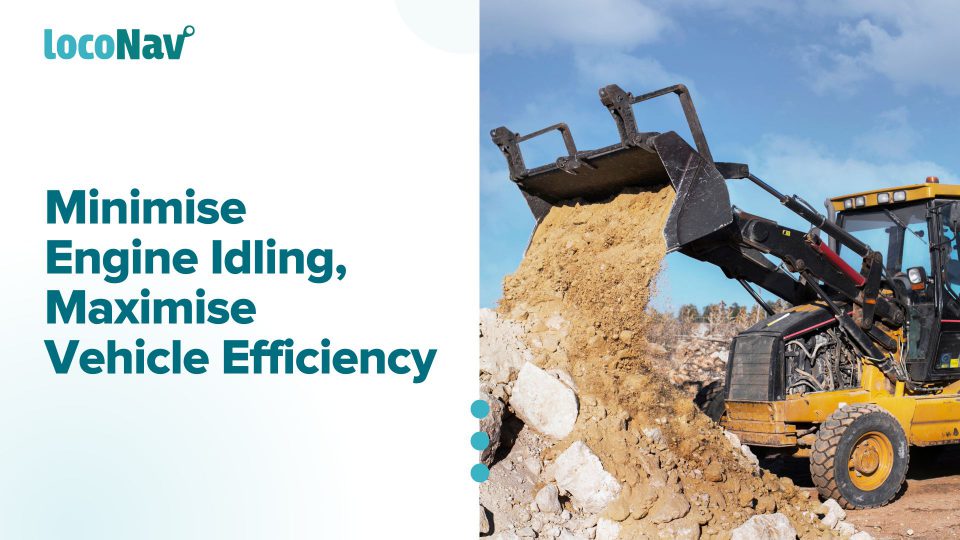

It is no mystery that construction vehicles and equipment are subjected to some of the harshest circumstances. Running for extended periods of time with the engine idling can be taxing on the engine’s health, causing more depreciation as well as unscheduled downtime and repairs.
Downtime can create significant disruption and have a negative impact on a company’s bottom line if it is not pencilled into a maintenance schedule. As a result, it is critical that construction equipment fleet management runs well, with dependability, efficiency, and safety as top priorities.
There are numerous elements that influence fuel efficiency and equipment efficiency, but even slight gains can be beneficial. As a result, all aspects should be analysed and optimised. In this blog, we will discuss one such aspect, which is often overlooked, i.e., fleet idling.
Manage your fleet efficiently with LocoNav’s Construction Equipment Fleet Management Solutions!
What is Vehicle Idling?
Let us first get the basics out of the way and understand what vehicle idling is.
When a vehicle’s engine is running when it is not in motion, it is referred to as idling. Idling in commercial vehicles and construction equipment fleet management is frequent.
Idling is not necessarily deliberate; many individuals idle every day while trapped in traffic or waiting in line at a drive-thru. Truckers frequently leave their engines running to generate power to keep cab temperatures stable while they sleep. Idling, whether purposeful or unintentional, burns the same quantity of fuel and emits the same level of pollutants without actually achieving any productivity.
Impact Of Idling On Construction Equipment Engines
On construction sites, heavy-duty equipment spends a significant period of time with an idle engine. Some fleets may idle substantially more than this owing to the operational nature of construction sites and the long periods of time when machinery is motionless. It is vital to remember that an hour of idling time has a similar effect on an engine as driving about 40 kilometres.
Idling has an effect on the combustion process by increasing the possibility of the fuel temperature dipping below 100 degrees. This can cause water to accumulate, causing fuel dilution and an increase in battery acids, increasing the rate of construction equipment engine depreciation.
Furthermore, because fuel expenditures are one of the most expensive costs for heavy equipment management, improving fleet fuel economy is a constant and continuous problem. Idling is rarely considered in an improvement programme, despite the fact that it is predicted that a large diesel engine can burn up to one gallon of fuel for every hour it is left idling.
Enhance Construction Equipment Fleet Management with LocoNav
LocoNav offers various features that help you enhance your construction equipment fleet management. Some of these are
- Real-Time GPS Tracking
When you can track your construction equipment in real-time, you can:
- Identify where your construction equipment is at all times, regardless of where it is.
- Determine whether the engine is running, the overall distance travelled, unauthorised use, and the exact location of each piece of equipment.
- Improve maintenance by providing detailed reports on previous service, mileage, engine hours, and idling.
- Understand vehicle efficiency through utilisation data that show whether assets are being used effectively.
- Manage your scheduling and routing more effectively with real-time location tracking
- Keep track of vehicles’ entry and exit at allotted times from job sites, and keep your assets safe with geofence alerts.
- Engine Immobilization
Fleet managers can use an engine immobiliser to remotely disable the ignition of any vehicle right from their LocoNav dashboards. This not only allows for managing remote access to fleet vehicles and other heavy machinery but also prevents asset theft.
- Idling Alerts
With real-time notifications, you can be warned immediately when your vehicle is idle. This allows you to
- Save money on fuel by reducing fuel waste caused by fleet idling.
- Make sure none of your vehicles are idling, which can significantly boost trip frequency.
- Extend engine life and decrease vehicle breakdowns by minimising excessive idling
- Reduce idling time by training and coaching drivers.
- Operator Identification
Make sure only authorised drivers are operating your expensive heavy machinery. Utilise LocoNav’s Video Telematics to identify drivers and operators on the job and reduce the chances of unauthorized usage and prevent theft.
- Fleet Safety
With route optimisation and route deviation alerts, fleet managers can ensure their drivers are away from high-risk areas and following designated routes. With driver and vehicle scorecards, managers can prevent drivers from engaging in unsafe driving practices.
LocoNav also allows for maintenance scheduling which can contribute to increasing asset lifespan by keeping a log of regular maintenance and tracking results to create servicing routines and reduce maintenance expenses.
Construction fleet managers are rapidly noting the significant fuel use by idling equipment, which can be a costly outcome. With the importance of reducing downtime in construction equipment fleet management, choosing the correct construction fleet management solution necessitates careful thought. As a result, for operators looking to improve fuel efficiency, engine idling represents an unmet opportunity for considerable economic, financial, and/or fuel gains.
